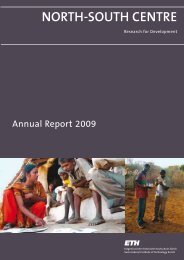Annual Report 2006/07 - ETH - North-South Centre North-South ...
Annual Report 2006/07 - ETH - North-South Centre North-South ...
Annual Report 2006/07 - ETH - North-South Centre North-South ...
Create successful ePaper yourself
Turn your PDF publications into a flip-book with our unique Google optimized e-Paper software.
Research fellow (Post-doc)Martin Jemo, <strong>ETH</strong> ZurichSupervisorsEmmanuel Frossard, Jan Jansa, IPW,<strong>ETH</strong> ZurichCollaboratorsFritz Oehl, University of Basel,Switzerland / Robert Abaidoo, IITA,Nigeria / Dieudonné Nwaga, Universityof Yaoundé 1, Cameroon / Jean Kuate,Institute of Agricultural Researchfor Development, CameroonDurationJune 20<strong>07</strong> – May 2009Research Fellow Partnership ProgrammeCan changes in the community structure of arbuscularmycorrhizal fungi contribute to explain the rapid yield decreaseof crops following forest clearance in <strong>South</strong>ern Cameroon?The proposed project is focused on a specific land use systemsequence found in the humid forest zone of <strong>South</strong>ernCameroon*. In this system, the major obstacle for sustainablecrop production is that yields are generally low and dramaticallydecline after a few cycles of cultivation following forestclearance. Traditionally, the sustainability of this systemrelies on combining long fallows and specific cropping systems,where nutrient demands of crops are covered throughweathering, biological nitrogen fixation and plant residuedecomposition. This assumes an important role for soilmicrobial communities during both the fallow as well as theproductive phase. Arbuscular mycorrhizal fungi (AMF), symbiontsof a large majority of terrestrial plants, belong to thisgroup of soil microorganisms and play an important role inthe uptake of nutrients such as phosphorus by plants fromthe soil, thus contributing to the crop yields especially undernutrient-limiting conditions. Furthermore, these fungi have amultitude of other functions in the plant-soil continuumsuch as affecting disease and pathogen tolerance of theplants, and alleviation of plant abiotic stresses (e.g. droughtand aluminium toxicity). However, the question whetherAMF community deterioration after forest clearance contributesto explain the rapid yield decrease in recently clearedfields in the humid tropics has not yet been investigated. Thegoals of this project are to (i) monitor crop development andnutrition, physico-chemical soil properties and mycorrhizalcommunities during four crop cycles following forest clearancein the benchmark site in <strong>South</strong>ern Cameroon, (ii) assessthe benefits of AMF communities present in soils under secondaryforests, in Chromolaena odorata fallow, and incropped fields on the growth and nutrition of maize, (iii) separatethe members of the AMF community present in soilsunder secondary forests, and test their compatibility withand benefits to maize, and (iv) to propose managementstrategies utilising the potential of mycorrhizal symbiosis forcrop production on soils with widespread N and P deficiencyas well as Al toxicity. Field experiments are presently beingestablished at the village of Metet where the relationshipsbetween the composition and activity of AMF communitiesand yields of maize will be investigated. Treatments include:Phosphorus (P) fertiliser application (TSP, 30 kg P/ha), thefungicide Benomyl (50 kg/ha), the combination of P andBenomyl application and a control treatment.a b cField experimental sites were cleared and prepared for sowing in Metet during theSummer of 20<strong>07</strong> with (a) secondary forest site, (b) Chromolaena fallow, and (c)cropped field.*A (secondary) forest is slashed and burned and mixed-crop fields with groundnuts, maize, soybean, plantain, cassava and other crops are established. After several croppingseasons, the land is subjected to herbaceous fallow (mostly dominated by Chromolaena odorata). The land is cultivated again after a few seasons and this cycle is repeated2–3 times. Then the yields are so low that the land is abandoned for 10–30 years, allowing the establishment of secondary forest through natural succession.61
















